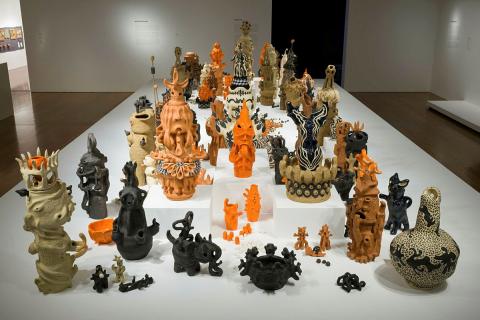Mai Nguyễn-Long: Vomit Girl
By Abigail Bernal
‘11th Asia Pacific Triennial’ | exhibition catalogue | November 2024
Born 1970, Hobart, Australia
Lives and works in Bulli, Dharawal Country, Australia
Mai Nguyễn-Long’s experience of growing up in different countries, including Papua New Guinea and the Philippines, left her eager to discover more about Việt Nam — the country of her father’s birth. In the early 1990s, when Việt Nam reopened to the outside world, she seized the opportunity to live and study in Hà Nội, learning Vietnamese through cultural absorption and systematic effort. When she returned to Australia, Nguyễn-Long discovered the communist connotations of her northern accent were deeply frowned on by the diasporic community, who were predominantly from the south. Subsequently, an exhibition of her work at Casula Powerhouse Arts Centre, Sydney, resulted in protests and censorship by the same community. This was a deeply distressing experience for the artist that cut her off from her Vietnamese heritage for many years.
These biographical experiences are significant to understanding Nguyễn-Long’s practice, and particularly the character of Vomit Girl — who first emerged in the artist’s paintings and drawings as a visceral response to her experience of rejection. Vomit Girl (alternatively ‘Vigit’ or ‘Kôgábịnô’) signifies not only voicelessness, silencing and untranslatability, but also resistance and a means of healing and reconnection. As the artist explains:
The recurring vomit motif came from a sense of being erased: having no identity, language, or voice to speak with. There is overwhelming sadness and confusion about how to bridge the dense chasm of exclusionary narratives, misunderstandings, discrimination, rejection, and shame.1

A detail view of works in Mai Nguyễn-Long's The Vomit Girl Project 2024 / Glazed and unglazed clay / Commissioned for APT11 / With selected loans from the collections of Max Germanos; Kon Gouriotis; Stuart Horstman; Daniel Soma; and the artist / © Mai Nguyễn-Long / Photograph: C Callistemon © QAGOMA
Vomit Girl has a whimsical, playful side informed by concepts of mistranslation, wordplay and idiosyncratic readings of Vietnamese folklore. In developing this body of work, Nguyễn-Long returned to Vietnam in 2014, for the first time in more than a decade, and a year later started working with clay in the ceramic village Bát Tràng in Hà Nội. Nguyễn‑Long learnt ceramics-making from observation, employing a Vietnamese rustic village-associated aesthetic she describes as ‘mộc mạc’ — reclaimed through her practice as an earthy embrace of imperfection in all its manifestations. As a means of reclaiming her cultural heritage, Nguyễn‑Long also pursued her interest in Vietnamese folklore and her fascination with the little-known wooden đình carvings that decorate local village halls.
Nguyễn-Long describes her Vomit Girl sculptures as ‘contemporary folkloric forms’. In the artist’s words, they emerge from the proposal that ‘contemporary art can draw from folkloric strategies to open up spaces for suppressed, hidden, and new stories to emerge beyond diasporic trauma’.2 The sculptures are made from various types of clay, from dark smooth grog clay with manganese and iron to terracotta clay with cellulose fibres, white raku clay and, occasionally, a lurid orange glaze that refers to Agent Orange. Each object has its own complex symbolism and genealogy, employing shapes and references derived from local experiences and histories. The basis for the body of every Vomit Girl is the ‘Doba’ (Đình Bombshell Bell Axis) form — a reference to a real bombshell repurposed as a village bell. The Worana (Worm-Dragon-Snake) is another important conceptual building block. Elephant fairies, toads, warrior cats, dancing birds, buffalo riders, mudskippers and screaming chickens are other captivating forms that emerge in the sculptures to create a refined, systematic and deeply engaging visual language.
The Vomit Girl Project 2024 includes many new works — from small objects that can be held in the palm of the hand to multi-part figures more than one metre tall — created specifically for the Asia Pacific Triennial. In keeping with the evolving nature of this body of work, Nguyễn-Long has employed a new deep blue glaze for some figures, and increased her use of drawing and incising with the unusual yet precise tools of teeth and a porcupine quill. As a group, these at once fragile and robust works demonstrate the artist’s skill with clay, a medium which allows her to forge new connections and associations as a form of decolonisation and creative resistance.

A detail view of works in Mai Nguyễn-Long's The Vomit Girl Project 2024 / Glazed and unglazed clay / Commissioned for APT11 / With selected loans from the collections of Max Germanos; Kon Gouriotis; Stuart Horstman; Daniel Soma; and the artist / © Mai Nguyễn-Long / Photograph: J Ruckli © QAGOMA
- Mai Nguyễn-Long, Vomit Girl beyond diasporic trauma: Interconnecting contemporary art and folkloric practices in Vietnam, University of Wollongong, PhD thesis, 2022.
- Nguyễn-Long, p.i.

Worana swirl 2024
- NGUYỄN-LONG, Mai - Creator


